Abstract
1. An investigation was carried out to determine whether the centrally acting hypotensive drugs whose mechanisms of action are due either to activation of 5-HT1A receptors (flesinoxan, 8-hydroxy-2-(di-n-propylamino)tetralin (8-OH-DPAT) and urapidil--also an alpha 1-adrenoceptor antagonist) or to activation of alpha 2-adrenoceptors (clonidine and moxonidine) cause differential sympathoinhibition. 2. Cats were anaesthetized with alpha-chloralose and simultaneous recordings were made of whole cardiac, splanchnic and renal nerve activity, blood pressure and heart rate. Cumulative dose-response (i.v.) curves were constructed in separate experiments for the above hypotensive agents on these parameters. 3. Renal nerve activity was found to be more sensitive to the sympathoinhibitory action of flesinoxan and 8-OH-DPAT when compared with cardiac nerve activity, whereas the reverse was observed for clonidine and moxonidine, cardiac being more sensitive than renal nerve activity. Splanchnic nerve activity was similarly affected by all drugs. Furthermore at the highest dose, all drugs tended to cause complete inhibition in all regional sympathetic nerve outflows. 4. Urapidil differed from all the above hypotensive drugs in that it caused a similar degree of sympathoinhibition in all sympathetic outflows at all doses. It is suggested that this may be due to the ability of urapidil to block central alpha 1-adrenoceptors in addition to stimulation of 5-HT1A receptors.
Full text
PDF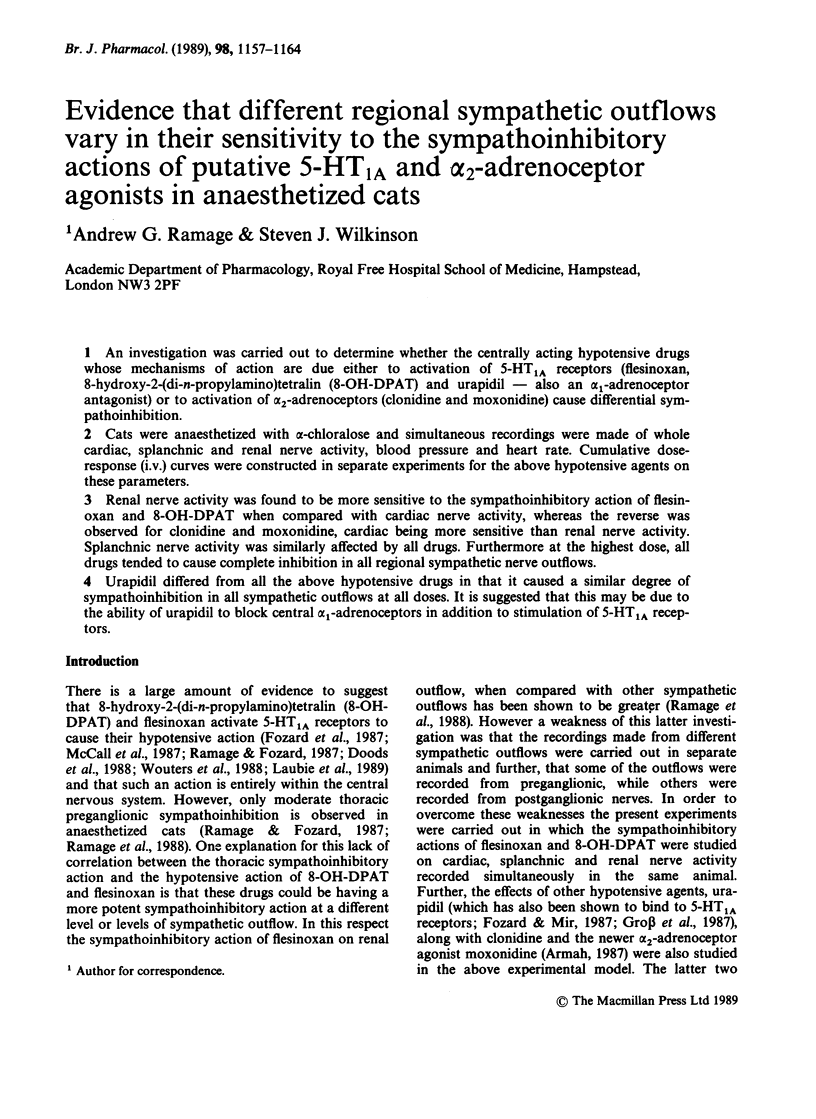
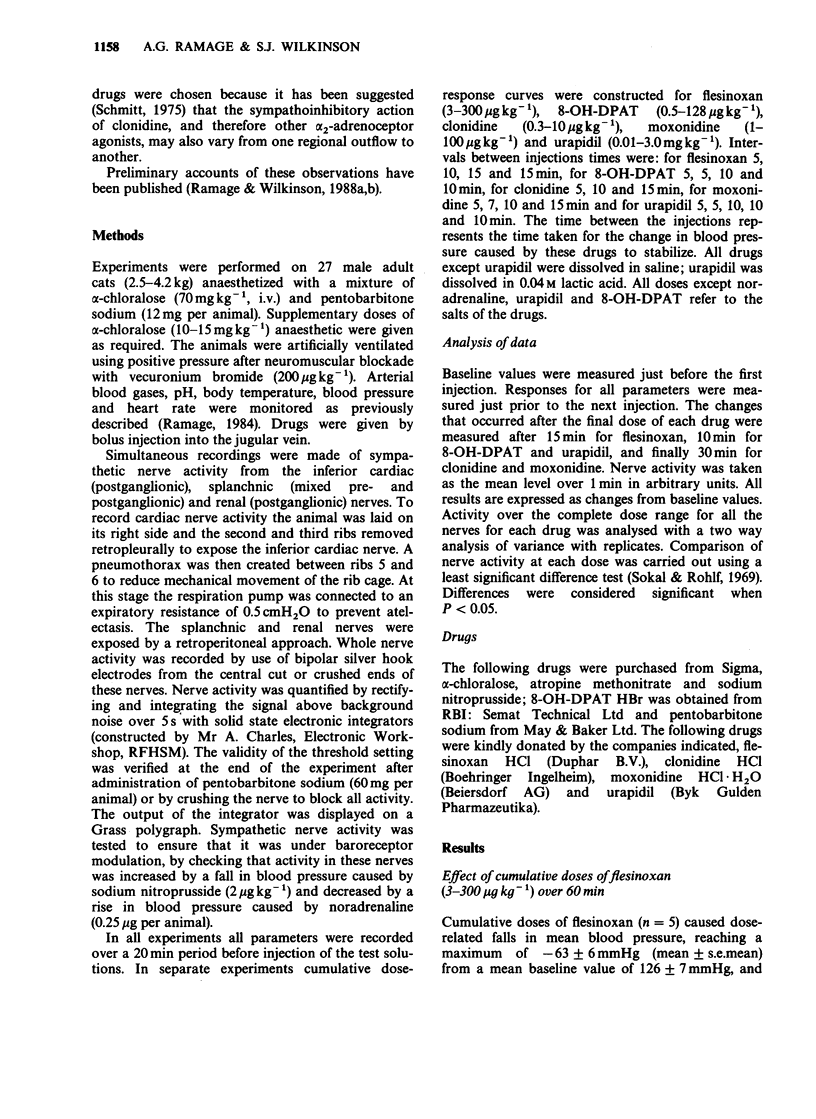
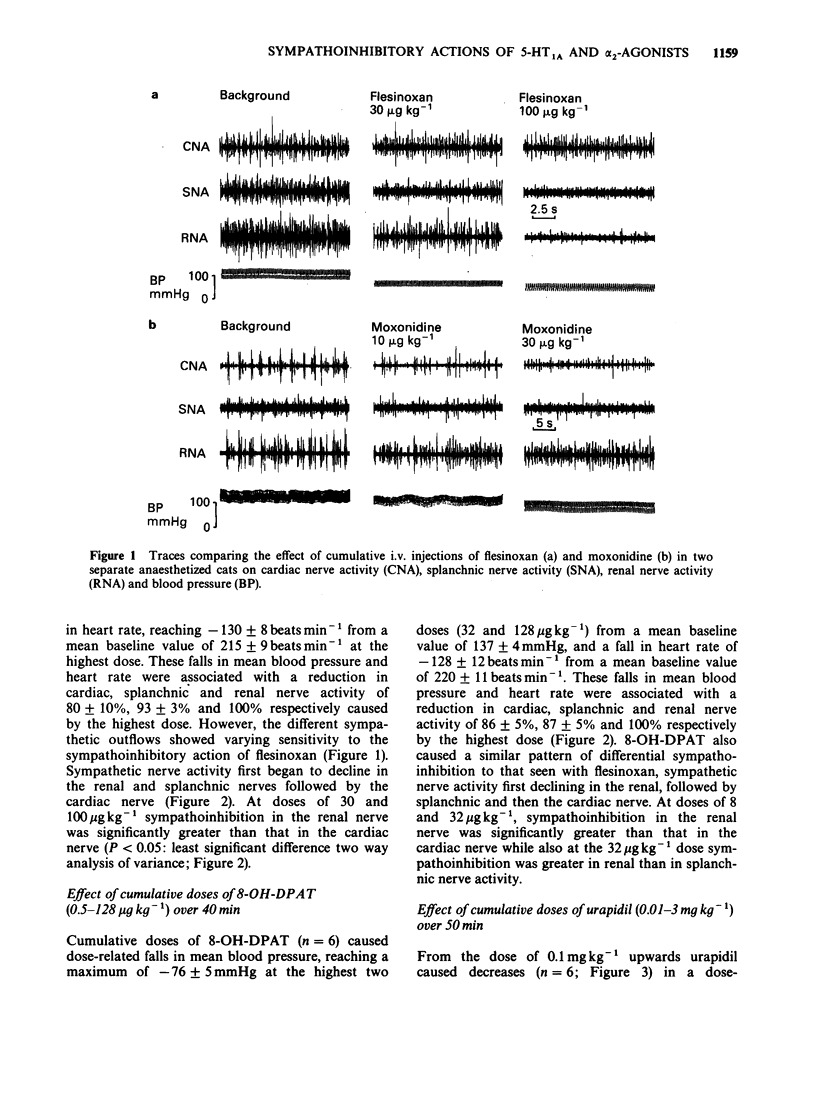
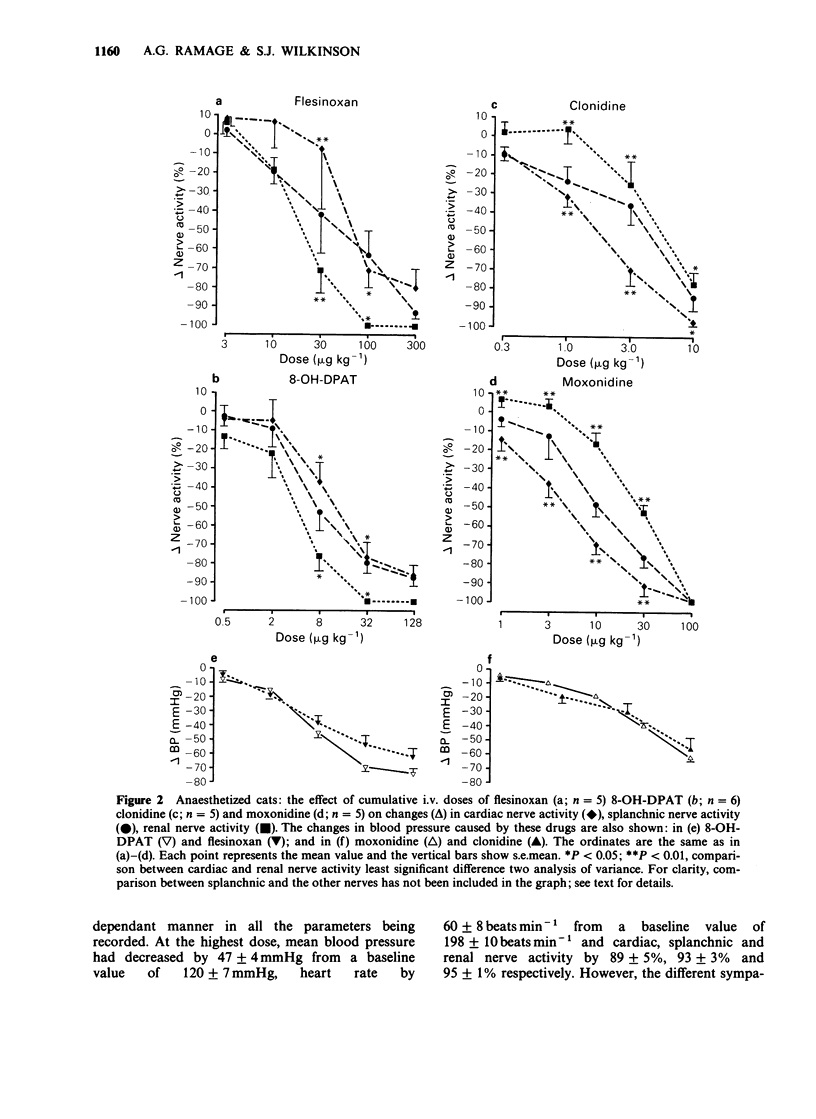

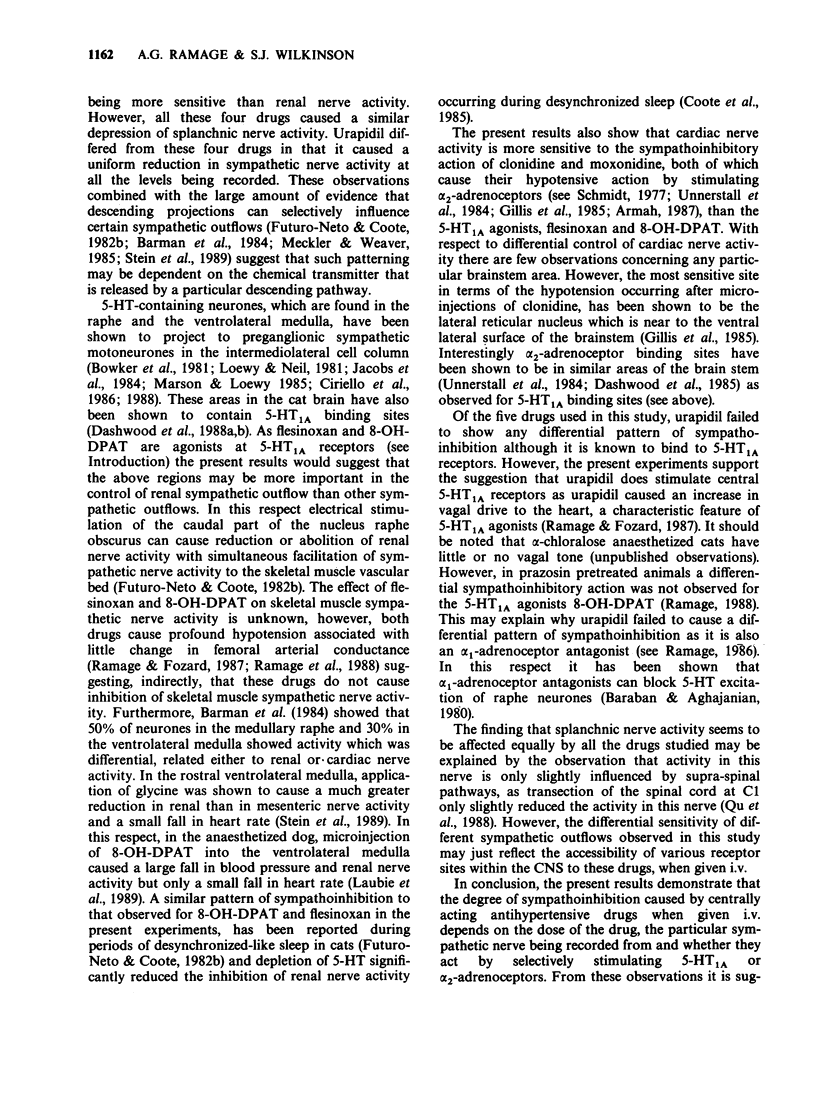
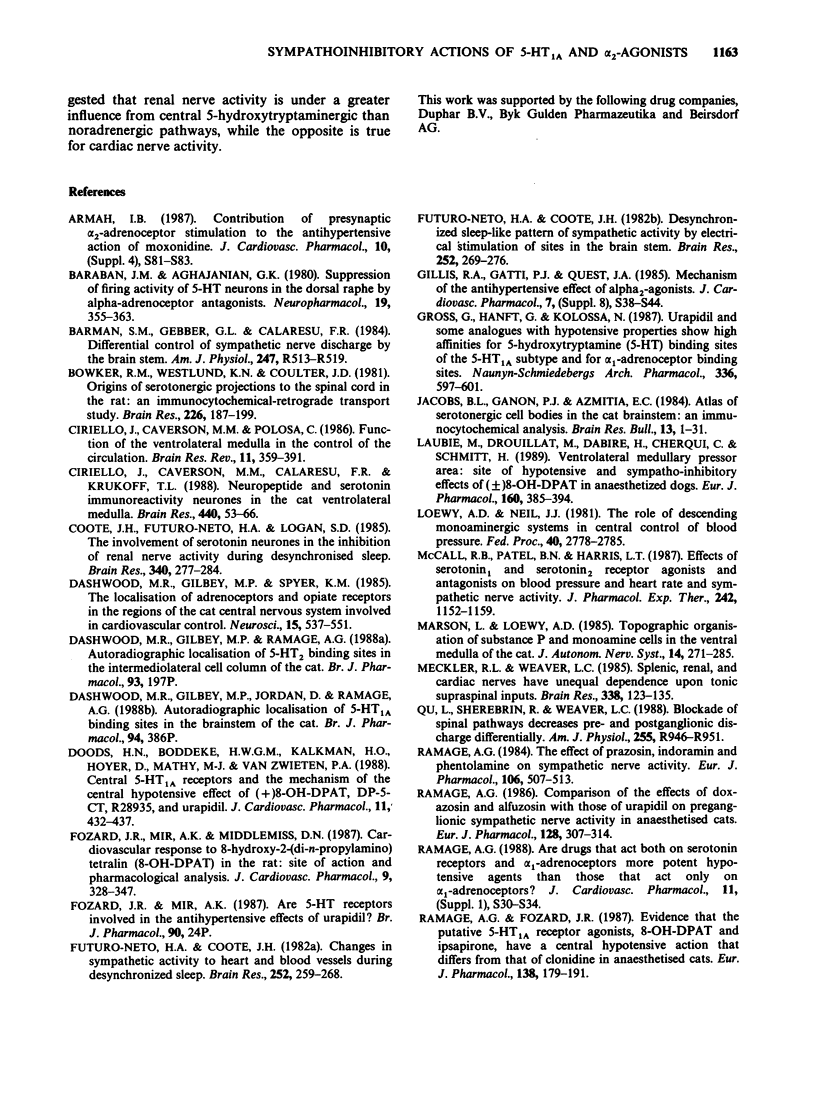
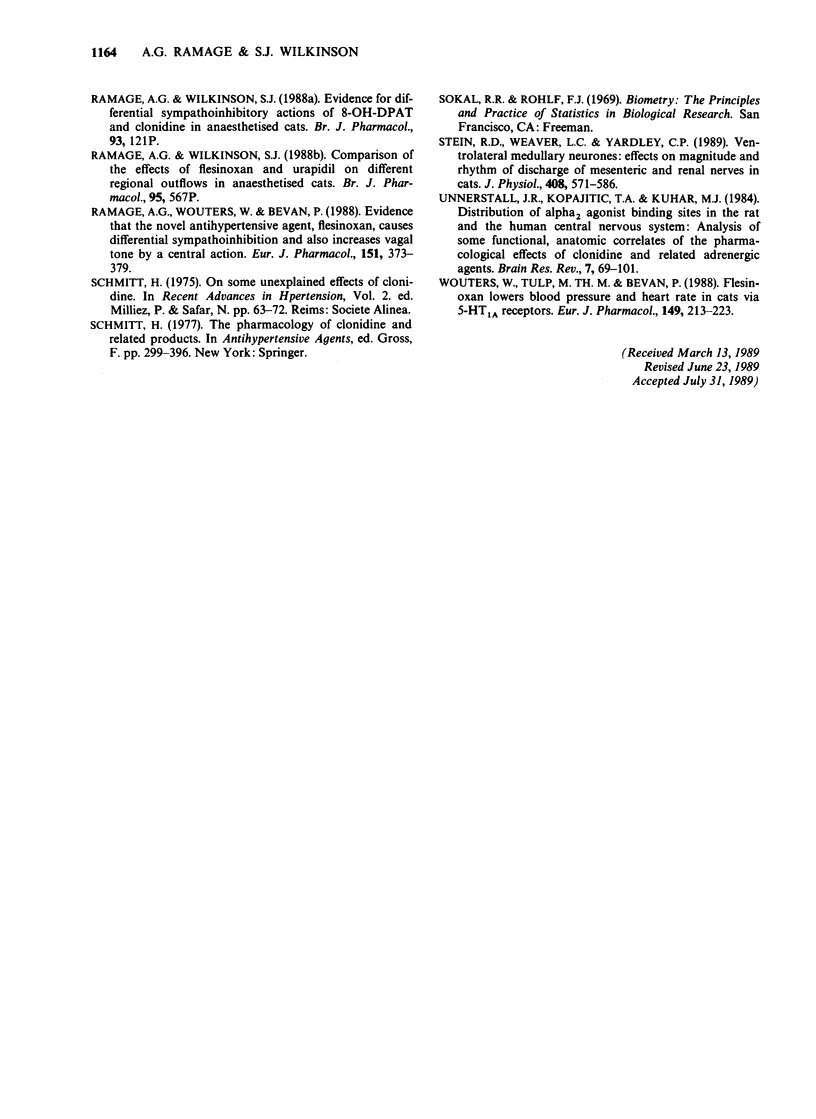
Selected References
These references are in PubMed. This may not be the complete list of references from this article.
- Baraban J. M., Aghajanian G. K. Suppression of firing activity of 5-HT neurons in the dorsal raphe by alpha-adrenoceptor antagonists. Neuropharmacology. 1980 Apr;19(4):355–363. doi: 10.1016/0028-3908(80)90187-2. [DOI] [PubMed] [Google Scholar]
- Barman S. M., Gebber G. L., Calaresu F. R. Differential control of sympathetic nerve discharge by the brain stem. Am J Physiol. 1984 Sep;247(3 Pt 2):R513–R519. doi: 10.1152/ajpregu.1984.247.3.R513. [DOI] [PubMed] [Google Scholar]
- Bowker R. M., Westlund K. N., Coulter J. D. Origins of serotonergic projections to the spinal cord in rat: an immunocytochemical-retrograde transport study. Brain Res. 1981 Dec 7;226(1-2):187–199. doi: 10.1016/0006-8993(81)91092-1. [DOI] [PubMed] [Google Scholar]
- Ciriello J., Caverson M. M., Calaresu F. R., Krukoff T. L. Neuropeptide and serotonin immunoreactive neurons in the cat ventrolateral medulla. Brain Res. 1988 Feb 2;440(1):53–66. doi: 10.1016/0006-8993(88)91158-4. [DOI] [PubMed] [Google Scholar]
- Ciriello J., Caverson M. M., Polosa C. Function of the ventrolateral medulla in the control of the circulation. Brain Res. 1986 Dec;396(4):359–391. doi: 10.1016/0165-0173(86)90005-6. [DOI] [PubMed] [Google Scholar]
- Cook N. S., Hof R. P. Cardiovascular effects of apamin and BRL 34915 in rats and rabbits. Br J Pharmacol. 1988 Jan;93(1):121–131. doi: 10.1111/j.1476-5381.1988.tb11412.x. [DOI] [PMC free article] [PubMed] [Google Scholar]
- Coote J. H., Futuro Neto H. A., Logan S. D. The involvement of serotonin neurones in the inhibition of renal nerve activity during desynchronized sleep. Brain Res. 1985 Aug 12;340(2):277–284. doi: 10.1016/0006-8993(85)90924-2. [DOI] [PubMed] [Google Scholar]
- Dashwood M. R., Gilbey M. P., Spyer K. M. The localization of adrenoceptors and opiate receptors in regions of the cat central nervous system involved in cardiovascular control. Neuroscience. 1985 Jun;15(2):537–551. doi: 10.1016/0306-4522(85)90232-5. [DOI] [PubMed] [Google Scholar]
- Doods H. N., Boddeke H. W., Kalkman H. O., Hoyer D., Mathy M. J., van Zwieten P. A. Central 5-HT1A receptors and the mechanism of the central hypotensive effect of (+)8-OH-DPAT, DP-5-CT, R28935, and urapidil. J Cardiovasc Pharmacol. 1988 Apr;11(4):432–437. doi: 10.1097/00005344-198804000-00008. [DOI] [PubMed] [Google Scholar]
- Fozard J. R., Mir A. K., Middlemiss D. N. Cardiovascular response to 8-hydroxy-2-(di-n-propylamino) tetralin (8-OH-DPAT) in the rat: site of action and pharmacological analysis. J Cardiovasc Pharmacol. 1987 Mar;9(3):328–347. doi: 10.1097/00005344-198703000-00010. [DOI] [PubMed] [Google Scholar]
- Futuro-Neto H. A., Coote J. H. Changes in sympathetic activity to heart and blood vessels during desynchronized sleep. Brain Res. 1982 Dec 9;252(2):259–268. doi: 10.1016/0006-8993(82)90393-6. [DOI] [PubMed] [Google Scholar]
- Futuro-Neto H. A., Coote J. H. Desynchronized sleep-like pattern of sympathetic activity elicited by electrical stimulation of sites in the brainstem. Brain Res. 1982 Dec 9;252(2):269–276. doi: 10.1016/0006-8993(82)90394-8. [DOI] [PubMed] [Google Scholar]
- Gillis R. A., Gatti P. J., Quest J. A. Mechanism of the antihypertensive effect of alpha 2-agonists. J Cardiovasc Pharmacol. 1985;7 (Suppl 8):S38–S44. [PubMed] [Google Scholar]
- Gross G., Hanft G., Kolassa N. Urapidil and some analogues with hypotensive properties show high affinities for 5-hydroxytryptamine (5-HT) binding sites of the 5-HT1A subtype and for alpha 1-adrenoceptor binding sites. Naunyn Schmiedebergs Arch Pharmacol. 1987 Dec;336(6):597–601. doi: 10.1007/BF00165749. [DOI] [PubMed] [Google Scholar]
- Jacobs B. L., Gannon P. J., Azmitia E. C. Atlas of serotonergic cell bodies in the cat brainstem: an immunocytochemical analysis. Brain Res Bull. 1984 Jul;13(1):1–31. doi: 10.1016/0361-9230(84)90003-0. [DOI] [PubMed] [Google Scholar]
- Laubie M., Drouillat M., Dabiré H., Cherqui C., Schmitt H. Ventrolateral medullary pressor area: site of hypotensive and sympatho-inhibitory effects of (+/-)8-OH-DPAT in anaesthetized dogs. Eur J Pharmacol. 1989 Feb 7;160(3):385–394. doi: 10.1016/0014-2999(89)90094-0. [DOI] [PubMed] [Google Scholar]
- Loewy A. D., Neil J. J. The role of descending monoaminergic systems in central control of blood pressure. Fed Proc. 1981 Nov;40(13):2778–2785. [PubMed] [Google Scholar]
- Marson L., Loewy A. D. Topographic organization of substance P and monoamine cells in the ventral medulla of the cat. J Auton Nerv Syst. 1985 Nov;14(3):271–285. doi: 10.1016/0165-1838(85)90116-x. [DOI] [PubMed] [Google Scholar]
- McCall R. B., Patel B. N., Harris L. T. Effects of serotonin1 and serotonin2 receptor agonists and antagonists on blood pressure, heart rate and sympathetic nerve activity. J Pharmacol Exp Ther. 1987 Sep;242(3):1152–1159. [PubMed] [Google Scholar]
- Meckler R. L., Weaver L. C. Splenic, renal, and cardiac nerves have unequal dependence upon tonic supraspinal inputs. Brain Res. 1985 Jul 8;338(1):123–135. doi: 10.1016/0006-8993(85)90254-9. [DOI] [PubMed] [Google Scholar]
- Qu L., Sherebrin R., Weaver L. C. Blockade of spinal pathways decreases pre- and postganglionic discharge differentially. Am J Physiol. 1988 Dec;255(6 Pt 2):R946–R951. doi: 10.1152/ajpregu.1988.255.6.R946. [DOI] [PubMed] [Google Scholar]
- Ramage A. G. A comparison of the effects of doxazosin and alfuzosin with those of urapidil on preganglionic sympathetic nerve activity in anaesthetised cats. Eur J Pharmacol. 1986 Oct 7;129(3):307–314. doi: 10.1016/0014-2999(86)90440-1. [DOI] [PubMed] [Google Scholar]
- Ramage A. G. Are drugs that act both on serotonin receptors and alpha 1-adrenoceptors more potent hypotensive agents than those that act only on alpha 1-adrenoceptors? J Cardiovasc Pharmacol. 1988;11 (Suppl 1):S30–S34. [PubMed] [Google Scholar]
- Ramage A. G., Fozard J. R. Evidence that the putative 5-HT1A receptor agonists, 8-OH-DPAT and ipsapirone, have a central hypotensive action that differs from that of clonidine in anaesthetised cats. Eur J Pharmacol. 1987 Jun 19;138(2):179–191. doi: 10.1016/0014-2999(87)90431-6. [DOI] [PubMed] [Google Scholar]
- Ramage A. G. The effect of prazosin, indoramin and phentolamine on sympathetic nerve activity. Eur J Pharmacol. 1984 Nov 27;106(3):507–513. doi: 10.1016/0014-2999(84)90054-2. [DOI] [PubMed] [Google Scholar]
- Ramage A. G., Wouters W., Bevan P. Evidence that the novel antihypertensive agent, flesinoxan, causes differential sympathoinhibition and also increases vagal tone by a central action. Eur J Pharmacol. 1988 Jul 14;151(3):373–379. doi: 10.1016/0014-2999(88)90533-x. [DOI] [PubMed] [Google Scholar]
- Stein R. D., Weaver L. C., Yardley C. P. Ventrolateral medullary neurones: effects on magnitude and rhythm of discharge of mesenteric and renal nerves in cats. J Physiol. 1989 Jan;408:571–586. doi: 10.1113/jphysiol.1989.sp017477. [DOI] [PMC free article] [PubMed] [Google Scholar]
- Unnerstall J. R., Kopajtic T. A., Kuhar M. J. Distribution of alpha 2 agonist binding sites in the rat and human central nervous system: analysis of some functional, anatomic correlates of the pharmacologic effects of clonidine and related adrenergic agents. Brain Res. 1984 Mar;319(1):69–101. doi: 10.1016/0165-0173(84)90030-4. [DOI] [PubMed] [Google Scholar]
- Wouters W., Tulp M. T., Bevan P. Flesinoxan lowers blood pressure and heart rate in cats via 5-HT1A receptors. Eur J Pharmacol. 1988 May 10;149(3):213–223. doi: 10.1016/0014-2999(88)90651-6. [DOI] [PubMed] [Google Scholar]


